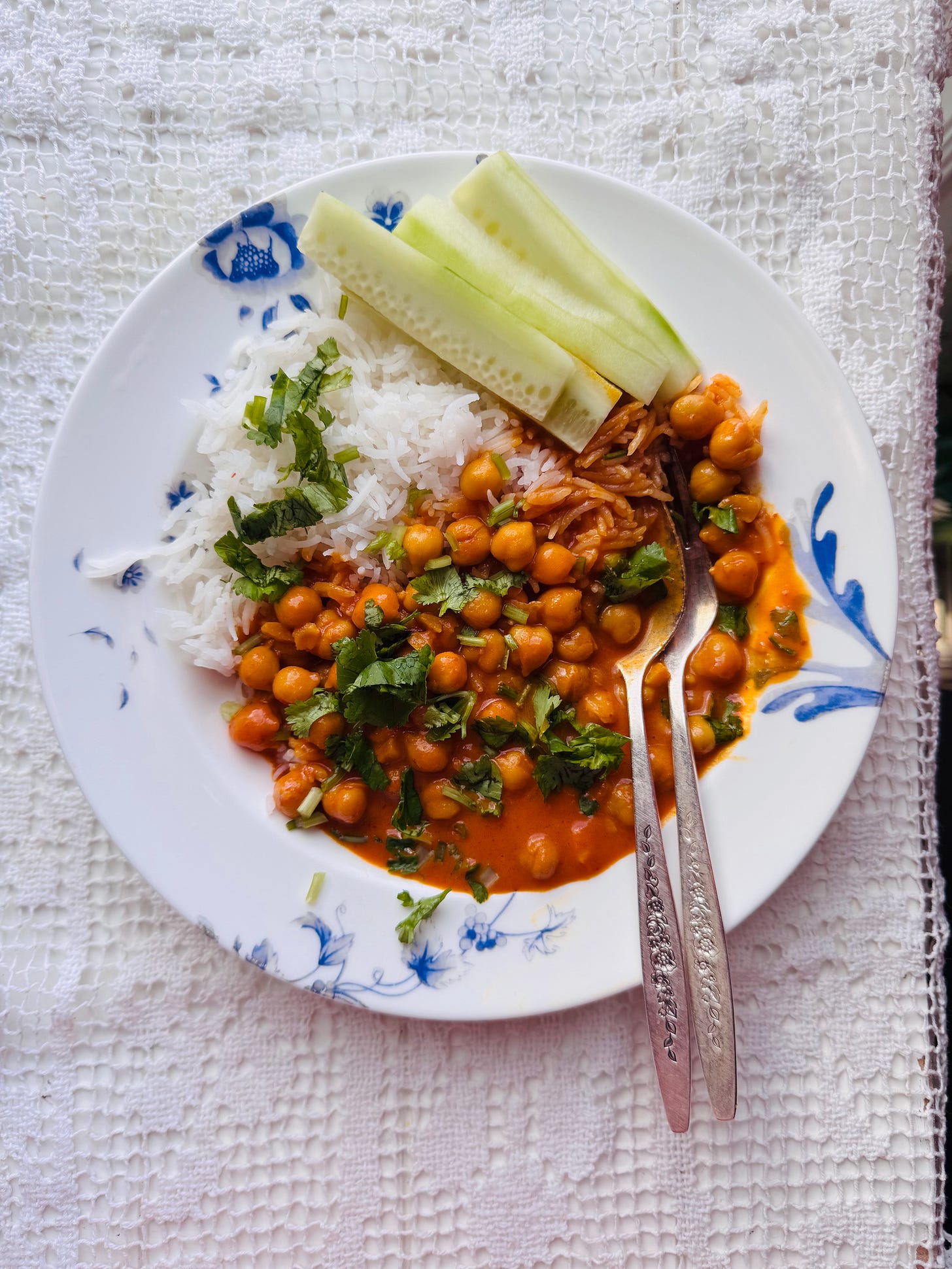When I was a child, my Ami, my mother, often said you could tell how someone was feeling by the way they moved in the kitchen. If the onions were burnt, or the basmati was overcooked, it wasn’t just carelessness, it was a reflection of something deeper. I never understood what she meant back then. To me, the kitchen was just a place where food appeared, and she always seemed so steady, so sure.
It wasn’t until I grew older, until the kitchen became my own space, that her words began to make sense. There are days when my movements are confident and quick, my hands remembering what to do before my mind catches up. And then there are days like the ones I’ve just had, when the kitchen felt a world away, and even the thought of chopping an onion seemed too much.
There’s something about being unwell that makes the world tilt ever so slightly. I found myself in that haze after the holidays, when I was too tired to move and too weak to care. I was cared for by my husband, who brought bowl after bowl of golden chicken broth, to my bedside, nourishing me, but after a few days I could not bear the sight (nor mention) of anything broth-related.
As grateful as I was, something felt missing. It wasn’t the food—it was me.
I was missing the act of creating, of pouring myself into something that I love, which is feeding myself and those around me. And so, the first day I felt well enough to stand for more than a few minutes, I knew exactly what I was going to make: Chana Masala and steamed basmati.
In my family, Chana Masala is both ordinary and extraordinary. It’s a dish that feels like home, one that has graced our table for as long as I can remember. I used to watch Ami make it, her hands moving instinctively, never measuring a single thing, trusting her eyes and her heart. No recipe cards, just memory.
Chana masala tethers me to home in a way few other dishes do. No matter where I’ve lived in the world, it’s always found a place on my table. I made it often when I lived in Rome, and it was there, in my kitchen with a window overlooking Piazza Nicoloso da Recco, that Ami taught me how to make it.
So, I pulled myself into the kitchen today, and began chopping, which is how every dish begins. I started with the Holy Trinity of Pakistani cookery: Onions, Ginger, Garlic. And slowly, the intimate rhythm of cooking returned. The onions softened in the oil, turning golden along the edges, and then I added garlic and ginger, the sound of the sizzle and the heady scent so familiar to me.
As the base of the Chana Masala came together, I turned my attention to the basmati rice. I had already rinsed it under cold water, watching the grains swirl and the cloudy water run clear, before letting it soak—a small but essential ritual I’d watched Ami go through countless times. There’s something meditative about preparing basmati, about the care it requires to yield those long, perfectly steamed grains.
As I stirred my pot of chickpeas, I followed all the steps I knew by following Ami’s recipe all these years, but I had to put a bit of me in the recipe, too. So I popped open a can of full-cream coconut milk and poured it in, transforming the deep red of the chickpea curry into a mellow, burnt orange. Sweet and creamy, it softened any sharp edges in the curry.
My basmati was gently steaming on the side, each grain perfectly cooked. I took it carefully out of the pot, using an espresso saucer just as my mother had taught me, to keep every grain intact. I ladled the Chana Masala over the rice, the creamy curry pooling around the edges, and added a few slices of crisp cucumber. And then some freshly chopped coriander. Their sweet stems (which people mistakenly discard) are my favorite.
Sitting down at the table, I took my first bite. Sweet, spicy, warm, creamy. It was everything I had been longing for. After days of feeling lost, this simple meal brought me back to myself.
Ami’s Chana Masala (with additions by me)
Ingredients:
¼ cup/60 ml vegetable oil
½ cup/~75g red onion, sliced into half-moon shapes (~1/2 a small onion)
4-6 cloves garlic, finely minced
2-inch/5-cm thumb ginger, finely minced
1 tsp sea salt, or more to taste
1 tsp hot smoked paprika
½ tsp ground cayenne
½ tsp ground turmeric
1 cup/250 ml tomato sauce
2 15-oz /450 ml cans cooked chickpeas, including aquafaba (the liquid the chickpeas are immersed in)
½ cup/120 ml full-cream coconut milk
Cilantro/coriander, coarsely chopped, for garnish
Preparation:
Heat oil in a large saucepan over medium heat. Add sliced onions and sauté, stirring occasionally, until golden around the edges. Add minced garlic and ginger, and cook until fragrant, being careful not to let them brown. Stir in the sea salt, hot smoked paprika, ground cayenne, and ground turmeric, and cook until the spices are fragrant. Pour in tomato sauce and stir to combine (it will sputter, so be careful). Add the chickpeas along with their aquafaba and stir. Pour in coconut milk, lower the heat to a simmer, and cover with a lid. Allow the curry to simmer for about 10 minutes. Remove the lid, check for seasoning, and adjust salt if needed. Garnish with coarsely chopped cilantro/coriander before serving.






Beautiful and evocative writing as always ❤️